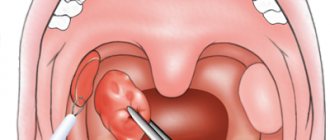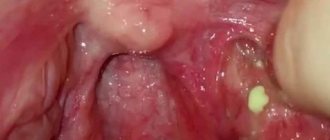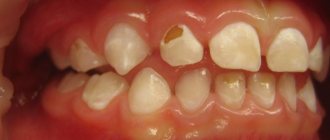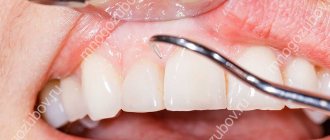What are white dots on the tonsils
Plaque can take the form of single white dots of varying sizes - from one to several millimeters. Their consistency can be soft, cheesy (caseous), dense or hard.
Every day, the tonsils encounter microbes that enter through the nasopharynx. In the lacunae, pathogenic microorganisms come into contact with the epithelium of the tonsils. In response to the penetration of bacteria, local inflammation develops. It activates the immune system and the production of antibodies.
The epicenter of resistance to infection is the follicles of the tonsils. They are groups of lymphoid immunocompetent cells. The result of the struggle is accumulation of destroyed cells and bacteria in the lacunae and at the site of the follicles. Gradually the plugs are impregnated with calcium salts and harden.
The resulting white dots on the tonsils consist of:
- from the remains of dead leukocytes;
- destroyed epithelial cells;
- microbes;
- calcium salts.
Bacterial examination of the contents of plugs reveals streptococci, staphylococci, and pneumococci.
What kind of disease is this and what are its causes?
Chronic tonsillitis is the most common cause of plug formation.
In addition, white lumps on the tonsils may appear:
- with weakened immunity;
- frequent sore throats;
- herpetic infection;
- fungal infection - candidiasis;
- caries;
- viral infections - influenza, ARVI.
With and without fever
The appearance of white spots on the tonsils may be accompanied by an increase in temperature. This is observed:
- with follicular or lacunar tonsillitis;
- influenza and acute respiratory viral diseases;
- herpetic infection;
- exacerbation of chronic tonsillitis.
The tonsils enlarge, their hyperemia and swelling are revealed, their surface loosens.
White spots on the tonsils may appear without fever. This happens:
- with candidiasis;
- with chronic tonsillitis without exacerbation.
To establish the cause of white dots on the tonsils, it is necessary to do a bacteriological analysis of them.
White lumps with an unpleasant odor
With chronic tonsillitis, white lumps with an unpleasant odor appear in the tonsils. They often have a cheesy or hard consistency. They are called tonsilloliths. The putrid odor is caused by the activity of pathogenic microorganisms. The disease occurs without sore throat.
With inflammatory processes in the throat or nasopharynx, tonsillitis increases.
Other symptoms
With exacerbation of chronic tonsillitis, follicular or lacunar tonsillitis, in addition to plaque on the tonsils, there is a sore throat, difficulty swallowing, enlargement and tenderness of the submandibular lymph nodes. Symptoms of intoxication appear: headache, weakness, lack of appetite. At night there may be heavy sweats and sleep disturbances.
With acute respiratory viral infections, patients complain of body aches, pain in the muscles and when moving the eyeballs, cough, runny nose, and chest congestion.
Preventive measures
Most often, white plaque signals a decrease in the body’s immune function and the beginning of an inflammatory process. Hypothermia or heavy exercise can trigger an exacerbation.
To prevent this effect, it is recommended to maintain physical fitness with basic morning exercises. You should choose clothes in accordance with the season and weather conditions.
After the end of the summer season, it is appropriate to take complex vitamin formulations that will prevent a decrease in protective functions.
You can compensate for the deficiency of microelements necessary for normal life by including a large amount of vegetables, fruits, fish and meat (low-fat varieties) in your diet.
After ARVI in a child
Children suffer from acute respiratory viral diseases quite often. This is due to:
- immaturity of the child’s immune defense mechanisms;
- high crowding in children's groups.
Sometimes after an acute respiratory viral infection, white dots or spots are found on the child’s tonsils, enlargement, swelling of the tonsils, and redness of the palatine arches. This indicates the addition of a bacterial infection and the development of a sore throat. In this case, you should immediately seek medical help.
Timely and correct treatment of sore throat will protect the child’s body from complications.
A white coating may appear on the child’s tonsils without fever. This happens when oral thrush occurs. Thrush is a fungal disease caused by pathogenic fungi of the genus Candida. Candidiasis often develops during antibiotic treatment. The diagnosis is made based on examining a smear from the tonsil under a microscope. Specific antifungal drugs are used in treatment.
Symptoms of purulent plugs in the throat
What to do with tonsil plugs? First of all, it is important to understand that this may be a sign of chronic tonsillitis, or it may simply be individual characteristics of the structure and functioning of the tonsils. Therefore, it is important to pay attention to other possible symptoms:
- Periodic exacerbations, from 2-3 times a year: recurring tonsillitis is associated with the fact that there is a focus of infection in the tonsils.
- Redness and swelling of the palatine arches: they are susceptible to inflammation due to the close location of the tonsils. Adhesions may form between the arches and tonsils.
- Enlarged cervical lymph nodes.
- Long-lasting body temperature is about 37-37.2 °C.
- Fatigue, decreased activity and performance, increased fatigue.
Specific symptoms of the appearance of plugs in the lacunae of the tonsils include the feeling of a foreign body in the throat, sore throat, sore throat, and unpleasant, putrid odor from the mouth. Sometimes halitosis, or an unpleasant odor, is the only symptom, and it forces a person to examine the oral cavity and pharynx to determine the source. Upon external examination, curdled, white or yellowish tubercles on the tonsils are noticeable. Sometimes they are invisible until a person presses on the surface of the tonsil, for example, with the handle of a teaspoon.
How to remove white dots
In order to remove white lumps in the tonsils, use local antiseptic bactericidal agents. They are available in a wide range in the form of sprays, lozenges or tablets. Rinsing helps a lot. Traditionally, solutions of soda, table salt with iodine, furatsilin, chamomile and sage decoctions are used for this. You can use a solution of Metrogyl, Miramistin.
It is impossible to clean the tonsils from white lumps at home. This is done by an otolaryngologist by vacuum extraction of plugs or washing the tonsils with antiseptic solutions.
It is not recommended to remove a white dot containing pus from the tonsil on your own. In the acute period of the disease, this is prohibited.
White spots in a child's throat
In infants, the main cause of whitish plaque on the oral mucosa is candidiasis. This is due to the complete sterility of the baby’s skin and mucous membranes at birth.
Therefore, by inhaling air, receiving mother’s milk or formula from a bottle, or putting his fingers into his mouth, the baby populates the oral cavity with microflora. Sometimes in this way he becomes infected with a fungal infection, which causes unpleasant symptoms.
On the throat of a preschool child, a white coating most often forms against the background of acute tonsillitis.
Sore throat is an exclusively bacterial disease, fraught with serious complications, therefore it must be treated with the utmost care and not neglect antibiotics.
A red throat with white dots in a child rarely indicates the presence of diphtheria, since most modern people are vaccinated against this extremely dangerous infectious disease.
- Thick white snot in adults and children - causes and treatment
Attention
If you suspect the development of this pathology, you should immediately call an ambulance and go to the hospital inpatient department for the administration of anti-diphtheria serum. This can save a child's life.
In any case, if a child has spots on the tonsils, especially against the background of fever and poor general health, he should be seen by a doctor immediately.
Correct treatment
For the treatment of sore throat, or exacerbation of chronic tonsillitis, in an adult the following is prescribed:
- Broad-spectrum antibiotics.
- Irrigation or washing of the tonsils with an antiseptic solution.
- Gargling with bactericidal agents.
- Complex vitamin therapy to improve immunity.
- Physiotherapy.
White lumps on the tonsils are removed by vacuum cleaning the tonsils.
Accurate fulfillment of all doctor’s orders contributes to a quick recovery. Incorrect or self-treatment can lead to the development of complications.
Treatment of tonsillitis plugs
The appearance of plugs always indicates a long-term inflammatory process, so you should know not only how to treat purulent plugs on the tonsils, but also combine removal with measures to treat chronic tonsillitis in general. To do this, you should consult an otolaryngologist. Conservative treatment consists mainly of the use of medications. Anti-inflammatory therapy may also be prescribed. One way to cope with a sore throat and inflammation is to take the drug Tonzilgon® N. This is a herbal remedy that is widely used to treat acute and chronic tonsillitis. The drug helps reduce inflammation and sore throat and prevent the occurrence of new exacerbations.
In most cases, it is advisable to resort to medicinal gargling. The doctor may prescribe an antiseptic solution based on chlorhexidine or furacillin. In consultation with a specialist, inhalations can be performed. Rinsing the lacunae of the tonsils is a procedure that allows you to get rid of plugs; it is carried out strictly by a specialist using a syringe and a medicinal solution or using a special apparatus.
Surgery
A tonsillectomy is an operation to remove the tonsils. A radical method of treatment is used only according to strict indications, in cases where drug therapy does not give the desired results, and plugs continue to form again. The doctor will suggest treating pus in the tonsils by removing them if there is a high risk of complications in the heart, joints, too frequent relapses and exacerbations of tonsillitis.
ethnoscience
Removing tonsil plugs using folk remedies is not recommended. They can be located deep in the gaps, and besides, this is risky - the inflammation can intensify. Using rinses, you can soften the surface of the plugs to make them easier to remove. As a rinse solution, you can only use liquids at a comfortable temperature: a weak saline solution, a solution of water and soda, a warm chamomile infusion in the absence of allergic reactions.
How to clean plugs
Doctors do not recommend self-medication: the presence of traffic jams is a good reason to visit a specialist. Independent attempts to remove plugs can cause injury to lymphoid tissue, the development of serious bleeding, and the spread of the inflammatory process. A relatively safe method of removing plugs is to squeeze them out with the handle of a teaspoon or a spatula: only you need to press not on the tonsil itself, but on the side of it - on the very arch itself, behind which it is hidden. When pressing on the tonsils, the contents of the lacunae are brought out. It is important to rinse thoroughly before and after the procedure to remove blockages from the mouth.
Folk remedies
- Furacilin solution. Rinse at least 4 times a day.
- Saline solution. You can add a few drops of iodine.
- Chamomile decoction.
- Sage decoction.
- Honey. Dissolve 1 teaspoon no more than 1 time per hour.
- Lemon, citrus. Relieve pain and fight dangerous microorganisms.
- Garlic. When chewed, juice is released that kills harmful bacteria.
- Onion. Grind in a blender, breathe deeply over the pulp for 5 minutes.
Self-medication can be dangerous, because an unpleasant symptom occurs due to various reasons. Before using a folk remedy, consult your doctor.
Other causes of stones in the tonsils
In most cases, the cause of the formation of whitish plugs on the tonsils that have an unpleasant odor is chronic tonsillitis. But she is not the only one possible. White lumps on the tonsils can be found with the following diseases:
- Chronic sinusitis. With this disease, thick whitish or yellow mucus is produced, which accumulates in the larynx area. Clots of mucus become the culprits of the unpleasant odor from the mouth and lead to a strong cough with sputum, which may contain miniature whitish balls.
- Peritonsillar abscess that occurs against the background of advanced acute or chronic tonsillitis. The disease is characterized by the accumulation of pus in one of the tonsils. This pathological condition is accompanied by a sore throat, high body temperature and painful sensations in the neck.
- Oral candidiasis is another reason for the appearance of white balls in the throat. The disease, caused by the activation of fungi of the Candida albicans group, leads to the appearance of whitish deposits in any part of the oral cavity: on the tongue, inside the cheeks, gums, palate, tonsils.
The appearance of painless tumors in the tonsil area may indicate salivary gland cancer. Therefore, if any tumors or formations appear in this part of the oral cavity, you should consult a doctor as soon as possible.










